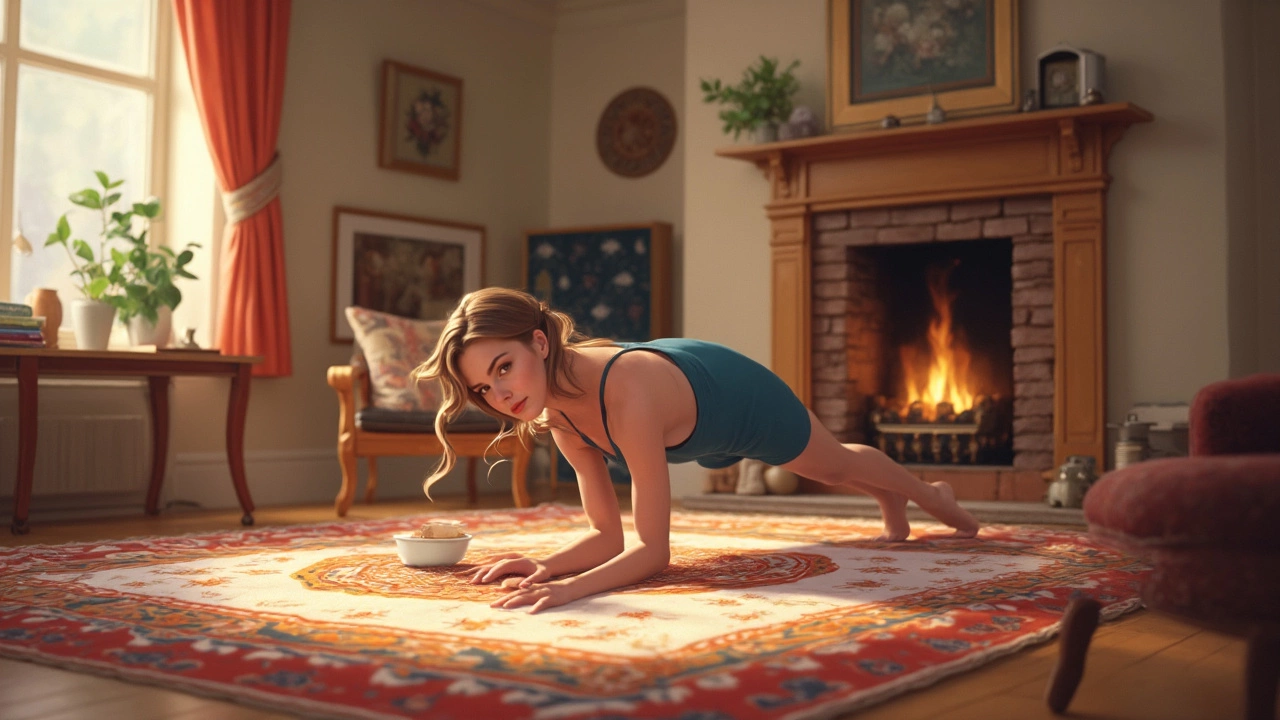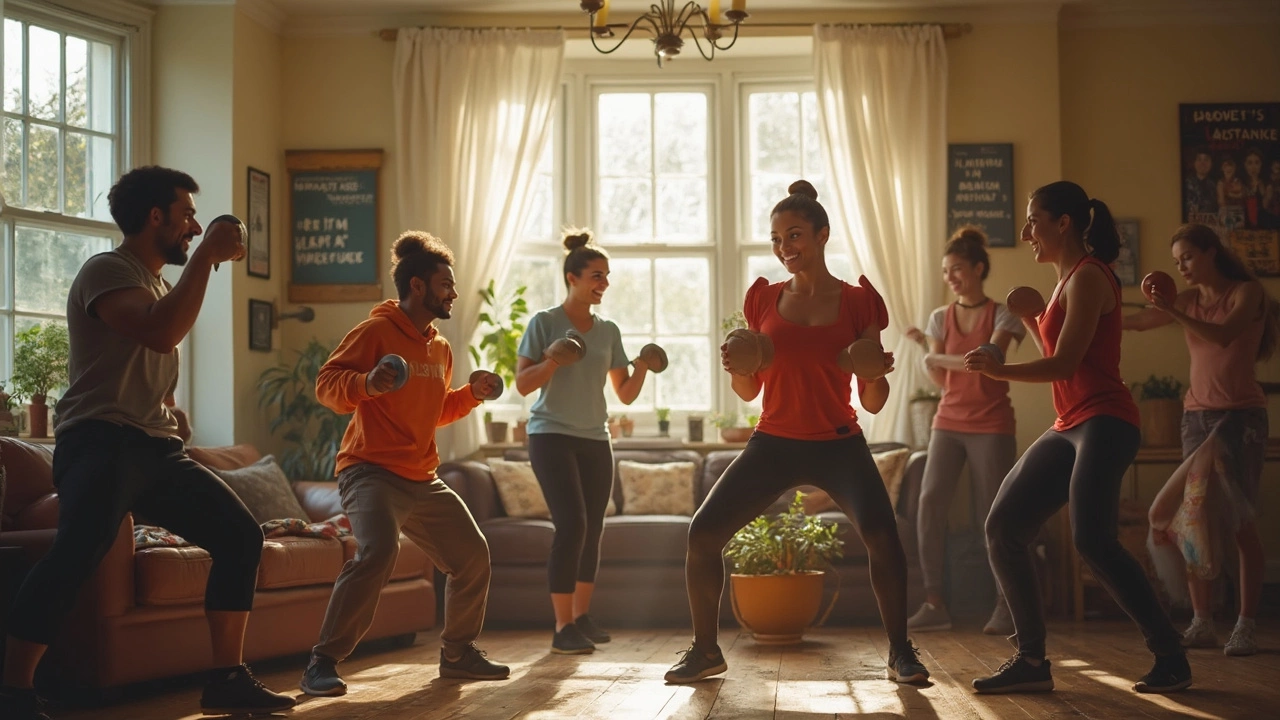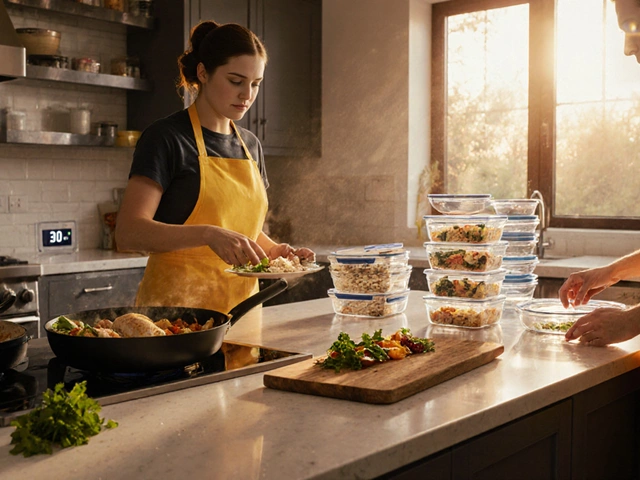Have you ever wondered if there's a single exercise that could rule them all? One that you can do at home, doesn't demand fancy gear, and hits the spot in terms of fitness gains? Say hello to the humble plank, a powerhouse move that's much more than a core crusher. Let me tell you why.
First off, with home workouts becoming increasingly popular, thanks to the perks like no commute and zero judgment from fellow gym-goers, the plank boasts some serious advantages. It engages multiple muscle groups at once, from abs and back to glutes and shoulders. And the best part? You don't need anything more than a bit of space and possibly a yoga mat if you're fancy.
More than just a core strengthener, the plank is known for boosting your posture, balance, and even mood. Surprised? Well, holding that plank position demands focus and breath control, which can do wonders for managing stress.
- Why Home Workouts Rock
- Meet the Star: The Plank
- Why Planking is King
- Planking with Equipment
- Tips to Perfect Your Plank
- Adding Variety to Your Routine
Why Home Workouts Rock
Home workouts have seriously transformed the way we keep fit, and there's a bunch of reasons why they've become a go-to option for so many fitness enthusiasts. For starters, the convenience of exercising at home means you can say goodbye to those long, exhausting drives to the gym. No need to cram a workout into a busy day or juggle time slots—you can exercise whenever it suits you.
One of the standout benefits is cost efficiency. Think about it: no gym membership fees, no classes to pay for, just home workout gear and maybe an internet connection for some online guidance. This means more savings for you in the long run.
For those with limited time, home workout sessions can be short yet effective. Plenty of apps and online platforms offer quick workouts that pack a punch in just 20 or 30 minutes. A simple setup with a mat, a pair of dumbbells, or a resistance band lets you dive into a productive session.
If you're worried about missing the variety that gyms offer, don't be! The breadth of exercises you can do at home has expanded massively. From cardio to strength training, flexibility workouts, and even meditation, the options are endless. The flexibility of mixing things up keeps the routine fresh and engaging.
Of course, another huge plus is privacy. No feeling self-conscious here! You can fall awkwardly out of a yoga pose or drop your dumbbells without anyone batting an eye. Perfect for building confidence in your abilities.
And, let's not forget, sweating it out at home means you're more likely to develop a consistent routine since bad weather or long commutes won't interfere with your plans. Ultimately, you create an environment where you're most comfortable, helping sustain motivation—whether you're a newbie or a seasoned pro. So, ready to step up your fitness equipment game?
Meet the Star: The Plank
Alright, let’s talk about the plank, the unsung hero of the home workout world. This exercise might look simple, but don’t be fooled—it’s a powerhouse of strength and stability. The plank is all about body tension, which means your whole body is in on the action. It’s a static exercise, where you hold a position for a period of time, engaging muscles in your core, shoulders, and even your legs to hold you up.
The beauty of the plank lies in its simplicity and effectiveness. It doesn’t rely on expensive fitness equipment or a gym membership, making it accessible to everyone. Just roll out a mat, get into position, and you’re set. For a classic forearm plank, you’ll want to keep your body in a straight line from head to heels, elbows directly beneath your shoulders, and your core pulled in tight.
Why is the plank so popular among fitness enthusiasts? Well, aside from targeting multiple muscle groups, it’s a fantastic tool for improving posture and even defining those much-coveted six-pack abs. Plus, it’s versatile. You can do it anywhere and there are tons of variations to keep things interesting, from side planks to plank jacks.
Let’s not forget the surprising benefits of mood improvement. Holding a plank requires focus and controlled breathing, which are excellent for mental clarity. Just one minute of planking can work wonders for shaking off stress.
And for the data nerds out there, let's throw in some numbers: a standard plank can burn between 2 and 5 calories per minute—that might not sound like much, but it's pretty decent for a static exercise. Most plank beginners start out holding the position for about 30 seconds, working their way up to over a minute as they get stronger.
If you’re looking to add a little variety with home workout equipment, a stability ball or even a resistance band can elevate your plank game to new heights. The plank is the Swiss army knife of exercises—it does a bit of everything and does it well.
Why Planking is King
Alright, let's talk about why the plank has practically earned its crown in the world of home workouts. Picture this: one move that manages to fire up multiple muscle groups without needing any extra equipment. Sounds like a dream for fitness enthusiasts and newbies alike, doesn't it?
One of the most fabulous things about planking is that it targets the core like nothing else, strengthening not just the abs but also the obliques, glutes, and lower back. Great for that toned midsection, sure, but it also means better posture and a lower risk of back injuries. Who doesn't want that?
And here's another win for the plank – it's adaptable. You can modify it to suit your fitness level, whether you're just starting out or you're well on your way to being the next fitness star. From the standard forearm plank to side planks and beyond, there's no shortage of variations to throw into the mix.
Get this: research shows that holding a plank for just one minute a day can make a noticeable difference in your strength. Imagine what you could achieve if you progressively increased the time or incorporated some of those fun variations.
Plus, let's not ignore the mental benefits. Planking requires concentration and perseverance, which can boost your mood and mental clarity. It's pretty cool how physical and mental fitness can go hand in hand this way.
There's no doubt the plank is a standout not just for its physical benefits but also for its practicality and versatility in any workout routine. It's no wonder it reigns supreme in the realm of home exercise.

Planking with Equipment
So, you've got the basics of planking down, and you're ready to spice things up a little? Adding some home workout equipment to the mix can elevate your planking game, offering more challenge and variety.
A simple way to start is by incorporating a fitness equipment staple: the stability ball. Balancing your feet or forearms on it while planking forces your core to work harder to keep you steady. It's like giving your body a stability challenge that your muscles will love—or hate, depending on how you look at it.
- Bosu Ball: This half-sphere is perfect for adding a wobble to your planks, engaging those deep core muscles.
- Resistance Bands: Wrap a band around your forearms or ankles to give your muscles something to burn for while holding steady.
- Weighted Vest: If you're feeling ambitious, throw on a weighted vest to boost the intensity. Start light, you don’t want to overwhelm yourself and compromise your form.
Feeling competitive or fancy tracking progress? Consider timing yourself and noting the duration you hold each version of a planking drill. Here's something interesting: holding a perfect plank for 60 seconds is often considered a benchmark of decent core strength.
And if you love numbers, check this out:
| Equipment | Effect on Muscles |
|---|---|
| Stability Ball | Engages more core stabilizers |
| Bosu Ball | Targets balance and core strength |
| Resistance Bands | Increases muscle activation | Weighted Vest | Boosts strength and endurance |
Dare to try planking with some gear, and who knows? You might unlock new levels of strength and keep the routine interesting, keeping you motivated to stick with your home workout groove.
Tips to Perfect Your Plank
Getting into the perfect plank takes more than just lying down on the floor and hoping for the best. But don’t worry, with a few tweaks, you can nail it like a pro.
First, think about your alignment. Your body should form a straight line from head to heels. No sagging hips or raised bumps here! Engage that core and keep those glutes tight. Imagine you’re a plank of wood—stiff and steady.
Your hands or elbows should be directly under your shoulders. It helps distribute the weight evenly, plus it minimizes strain on your joints. Keep your neck in a neutral position. Staring at the floor or craning up to the ceiling isn’t what we’re going for.
- Home workout spaces might not be perfect, so use a mirror or your phone camera to check your form until you get the hang of it.
- Breathe. Seriously, forgetting to breathe is common! Steady, controlled breaths help keep your focus and ease the tension.
- Start with short holds. Aim for 20-30 seconds, gradually increasing as you get stronger. No rush, quality over quantity!
- If your wrists protest, opt for a forearm plank. It’s equally effective and might be more comfortable.
Finally, consistency is your best buddy. Even a few minutes a day can show great results over time. Plus, planking is super flexible—combine it with other exercise tips for a balanced routine. Your body (and posture) will thank you!
Adding Variety to Your Routine
If doing a regular plank feels a bit too routine, you're in luck! There are tons of ways to spice things up and keep your home workout engaging. Adding variety can help target different muscles, prevent boredom, and keep you motivated.
First, let's shake things up with some plank variations. Try side planks to work on obliques or raise the intensity with a plank-to-push-up move. Want more? Experiment with a forearm plank and see how lowering your body challenges your core in new ways.
- Side Plank: Lie on one side, lift your body to balance on one forearm, and stack your feet. This targets your obliques and helps with balance.
- Plank-to-Push-Up: Start in a plank position, then push up into a push-up position, alternating arms. It's a fantastic way to work the upper body and core simultaneously.
- Forearm Plank: Lower yourself onto your forearms while maintaining the plank position. It emphasizes the core and shoulder muscles.
For those who love to make use of fitness equipment, incorporating tools like resistance bands or a stability ball can take your planking game to another level. Put your hands or feet on a stability ball to test your balance even more!
And hey, why not mix in completely different exercises to create a balanced routine? Combining planks with squats or lunges can round out your exercise session, giving full-body benefits without needing a ton of space or equipment.
By keeping your workouts diverse, you're not just working out your muscles but also keeping your mind engaged. Who says home fitness has to be boring?





